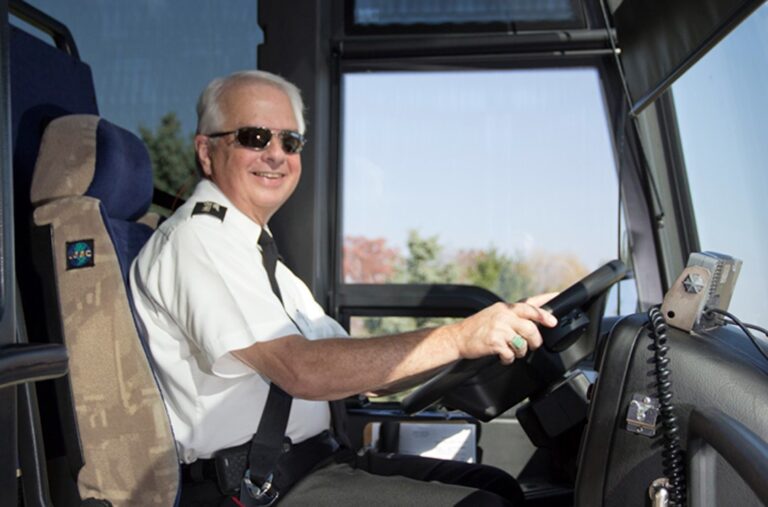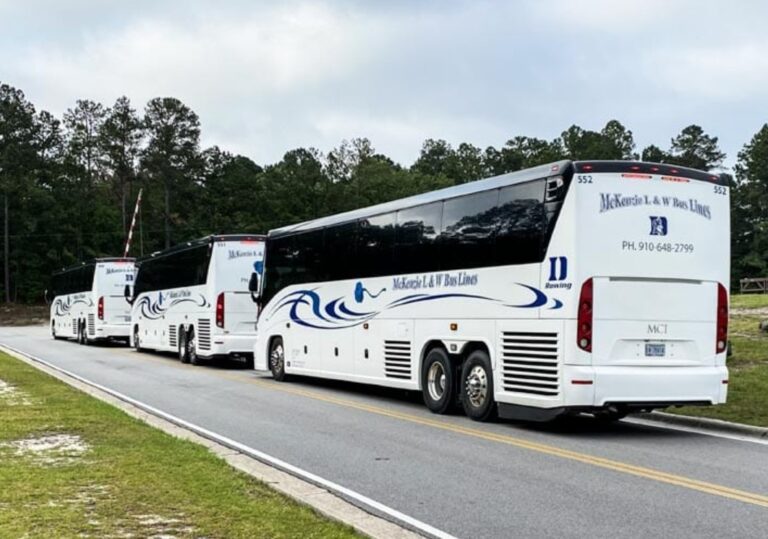Why Do School Buses Stop At Railroad Crossings? Answered
School buses are a common sight on our roads, safely transporting children to and from school. You may have noticed that these buses have a peculiar habit of stopping at railroad crossings, even when there isn’t a train in sight. Why is that? In this article, we’ll explore the reasons behind this practice, its importance, and the regulations governing it. We will come to know Why Do School Buses Stop At Railroad Crossings?
Key Takeaways
Before delving into the details, let’s summarize the key takeaways:
- School buses stop at railroad crossings as a safety measure to prevent accidents.
- Federal and state regulations mandate this practice to protect the lives of students on board.
- Drivers must follow specific procedures when approaching railroad crossings.
- It’s crucial for motorists to understand the reasons behind these stops to ensure everyone’s safety.
- The frequent stops may be an inconvenience, but they serve a vital purpose in safeguarding our children.
Now, let’s dive into the reasons behind school buses stopping at railroad crossings.
Why Do School Buses Stop At Railroad Crossings?
School buses stop at railroad crossings primarily for safety reasons. Federal and state regulations mandate this practice to prevent accidents and protect the lives of students on board. When approaching a railroad crossing, school bus drivers follow a “Stop, Look, and Listen” procedure to ensure there is no approaching train.

This caution is essential because trains can be fast and quiet, posing a significant danger in the event of a collision. While it may be an inconvenience for motorists, stopping at railroad crossings is a crucial safety measure to safeguard our children’s lives during their daily commute to school.
Ensuring the Safety of Students

Federal and State Regulations
The foremost reason why school buses stop at railroad crossings is safety. The safety of students on board is a top priority, and this practice is enforced by both federal and state regulations. These regulations exist to prevent accidents and protect the lives of young passengers.
Federal Regulations: The Federal Motor Carrier Safety Administration (FMCSA) sets guidelines for the safe operation of commercial motor vehicles, including school buses.
These regulations, found in the Code of Federal Regulations (CFR), Title 49, Section 392.10, mandate that school buses must stop at all railroad crossings. This federal law provides a clear directive for all school bus drivers operating across the United States.
State Regulations: In addition to federal regulations, each state may have its own specific rules regarding school bus operations. These state regulations can further outline the procedures and requirements for stopping at railroad crossings.
It’s essential for school bus drivers to be well-versed in both federal and state regulations to ensure compliance.
Preventing Tragic Accidents
The primary aim of these regulations is to prevent tragic accidents at railroad crossings. Collisions between trains and vehicles can have devastating consequences, especially when children are involved.
By requiring school buses to stop at all railroad crossings, authorities aim to reduce the risk of such accidents and protect the vulnerable occupants of the bus.
Understanding the Procedure
Stop, Look, and Listen
When a school bus approaches a railroad crossing, the driver must follow a specific procedure to ensure safety. This procedure is known as “Stop, Look, and Listen.” Here’s how it works:
- Stop: The bus comes to a complete stop at a safe distance from the railroad tracks, allowing the driver to assess the situation.
- Look: The driver must look both ways along the tracks to ensure there is no approaching train. This visual check is crucial to verify that it’s safe to proceed.
- Listen: While stopped, the driver must listen for any audible signals from the railroad crossing, such as bells, whistles, or train horns. This auditory check adds an extra layer of safety, especially in cases where visibility may be limited.
Crossing When Safe
Once the driver is certain that it’s safe to proceed, the bus can cross the railroad tracks. However, if there is any doubt or uncertainty about the safety of crossing, the driver must remain stopped until it’s entirely safe to continue the journey.
Addressing Common Concerns

Inconvenience for Motorists
Some motorists may find it inconvenient when a school bus stops at a railroad crossing, especially if there is no train in sight.
However, it’s crucial to understand that this practice is not arbitrary but rather a safety measure mandated by law. While it may briefly delay your commute, it plays a significant role in safeguarding the lives of children.
Benefits of Caution
It’s essential to recognize the benefits of caution at railroad crossings. Trains can approach quickly and quietly, and their size and speed make them highly dangerous in a collision.
By making it a standard practice for school buses to stop, federal and state authorities aim to reduce the risk of accidents, injuries, and fatalities.
School Bus Safety in Numbers
Let’s take a closer look at some statistics and facts regarding school bus safety and railroad crossings:
| Fact | Statistic |
| School buses transport over 25 million students daily in the United States. | According to the National Highway Traffic Safety Administration (NHTSA). |
| The majority of school bus-related fatalities occur outside the bus. | NHTSA data shows that pedestrians and occupants of other vehicles are most at risk. |
| School buses are designed with safety in mind. | They feature reinforced sides, stop signs, flashing lights, and high seatbacks to protect passengers. |
| According to the FMCSA, school buses are about seven times safer than passenger cars. | This is due to their design, size, and strict safety regulations. |
Facts
These facts underscore the critical importance of safety measures such as stopping at railroad crossings.
- School Bus Safety Tips for Parents: A guide for parents on how to educate their children about school bus safety and reinforce good habits.
- The Role of School Bus Monitors: Exploring the responsibilities of school bus monitors and their contribution to student safety.
- Emergency Procedures on School Buses: An overview of the protocols and practices in place to handle emergencies on school buses.
- School Bus Driver Training: Understanding the rigorous training programs that school bus drivers undergo to ensure the safety of their passengers.
- Seat Belts on School Buses: The debate surrounding the use of seat belts on school buses and their potential benefits.
- Alternative Transportation for Students: Examining alternative methods of transportation for students, such as walking or biking to school, and their safety considerations.
- The Importance of School Zone Safety: Discuss the significance of safety measures in and around school zones to protect students during drop-off and pick-up times.
- School Bus Maintenance and Safety: High-lighting the crucial role of regular maintenance in keeping school buses safe and reliable.
- School Bus Evacuation Drills: Exploring the importance of evacuation drills on school buses and how they prepare students for emergencies.
- The History of School Bus Safety: Tracing the evolution of school bus safety standards and regulations over the years.
- School Bus Safety Campaigns: An overview of various campaigns and initiatives aimed at raising awareness about school bus safety.
- Technology Advancements in School Bus Safety: Discuss the latest technological innovations and systems used to enhance school bus safety.
- Legal Consequences for Passing a Stopped School Bus: Explaining the legal penalties for drivers who illegally pass a stopped school bus, putting children’s safety at risk.
- Transporting Special Needs Students on School Buses: Addressing the unique challenges and safety considerations when transporting students with special needs.
- School Bus Safety During Inclement Weather: Tips and guidelines for school bus safety in adverse weather conditions such as rain, snow, or fog.
School buses stop at railroad crossings as a crucial safety measure mandated by federal and state regulations. The primary aim is to prevent tragic accidents and protect the lives of students on board.
These stops follow a strict “Stop, Look, and Listen” procedure, ensuring that it’s safe to cross the tracks. While this practice may inconvenience other motorists, it serves a higher purpose—ensuring the safety of our children during their daily commute.
Conclusion
In conclusion, the practice of school buses stopping at railroad crossings is not a random inconvenience but a necessary safety precaution. Federal and state regulations, along with the “Stop, Look, and Listen” procedure, are in place to safeguard our children from potential train collisions.
It’s vital for all motorists to understand and respect this practice, as it plays a crucial role in ensuring the safety of our most precious passengers. So, the next time you encounter a school bus at a railroad crossing, remember that it’s a momentary delay for a more profound cause—protecting the lives of our students.
Frequently Asked Questions
Why do school buses stop at railroad crossings even when there’s no train in sight?
School buses stop at railroad crossings as a safety precaution mandated by federal and state regulations. This practice ensures the safety of students on board by reducing the risk of accidents involving trains.
What is the “Stop, Look, and Listen” procedure that school bus drivers follow at railroad crossings?
The “Stop, Look, and Listen” procedure requires school bus drivers to:
Stop the bus at a safe distance from the tracks.
Look both ways along the tracks to ensure there is no approaching train.
Listen for audible signals from the crossing, such as bells or train horns, before proceeding.
Are these stops required by law?
Yes, these stops are mandated by federal law, specifically Title 49, Section 392.10 of the Code of Federal Regulations. State regulations may also reinforce these requirements.
Are school buses designed with safety features for railroad crossings?
Yes, school buses are designed with safety in mind. They often feature reinforced sides, stop signs, flashing lights, and high seatbacks to protect passengers. These safety features help reduce the risks associated with railroad crossings.
How often do accidents involving school buses at railroad crossings occur?
While accidents at railroad crossings involving school buses are relatively rare, the goal is to prevent them entirely. These safety measures are in place to minimize the risk of such incidents.

Welcome to the exhilarating world of Matt Rex, a professional car racer turned renowned vehicle enthusiast. Immerse yourself in his captivating blog as he shares heart-pounding adventures, expert reviews, and valuable insights on cars, trucks, jets, and more. Fuel your passion for speed and discover the beauty of vehicles through Matt’s engaging stories and meticulous expertise. Join the ever-growing community of enthusiasts who find inspiration and expert advice in Matt Rex’s blog—a digital hub where the thrill of speed meets the pursuit of knowledge.






